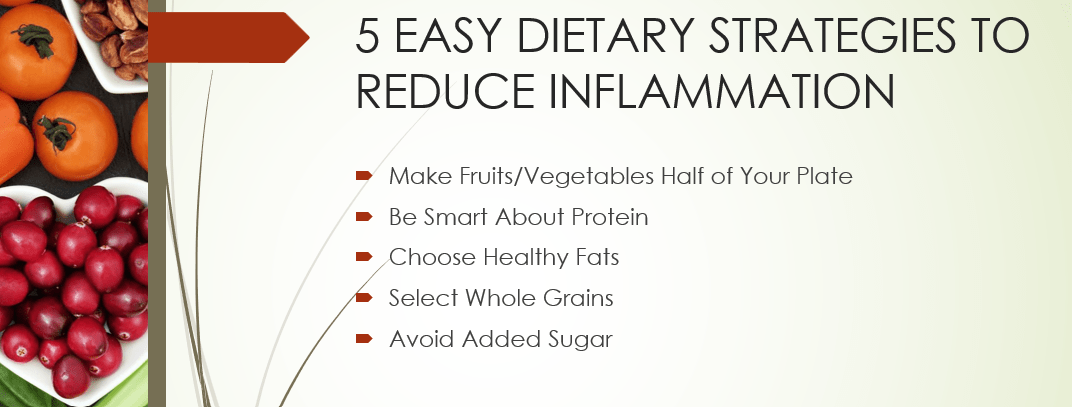5 Easy Dietary Strategies to Reduce Inflammation
Inflammation seems to be the latest buzz word and is blamed for every disease and illness. You may ask, “What is inflammation and how do I know if I have it?” Keep reading to find the answer.
If a person is admitted to the hospital for a burn, infection, wound or other acute illness like the flu, the doctors can measure the inflammation in their body using a blood test called c-reactive protein or CRP. The results would likely be elevated because it indicates their immune system is on alert and working to heal the problem. Inflammation is the bodies natural response to stress. The CRP would decrease as the person recovers and heals. In chronic illnesses like cancer, heart disease, or auto immune diseases, the CRP will typically still be elevated but at lower levels over longer periods of time. This chronic inflammation can do damage to our bodies.
Inflammation may be something you can see like a rash or redness on the skin, a swollen joint or a wound. It may be felt like achiness or pain in the joints or abdominal cramping, gas or bloating of the abdomen. Sometimes, inflammation may not be felt or noticed until a diagnosis like cancer, diabetes or heart disease occurs.
The short term, or acute, inflammation is not the problem. When our immune systems are strong, our bodies can fight off potential illnesses and heal cuts and sores effectively and efficiently in a speedy time frame. This type of inflammation is essential to keeping us healthy and won’t be the focus of today’s blog.
The long term, or chronic, inflammation can cause irreversible damage to our bodies. It is the underlying, slow burn inflammation which we may not even realize is there. What causes this chronic inflammation? I’m glad you asked….
Covering all of the above would take at least 8 blogs so let’s focus on the nutrition piece. We know that the food we eat can affect our bodies in both positive and negative ways. Certain foods provide our bodies with the nutrients to maintain a strong immune system, a healthy gastrointestinal tract and the necessary tools to fight off illness and disease. These include:
Fruits
Vegetables
Nuts/Seeds
Beans/Legumes
Whole grains
Monounsaturated Fats
Omega-3 fatty acids
Other foods have been shown to increase incidence of obesity and inflammation. These aren’t so much specific food groups as they are ingredients foods contain like:
saturated and trans fats
highly processed/refined grains
sugar and sugar sweetened beverages
***Food additives, preservatives, hormones and antibiotics, herbicides, pesticides and genetically modified foods can also be added to this list but yet again, is an entire, additional discussion to be saved for another date. Stay tuned!
In order to condense the above information, I pulled it into 5 main areas which can make a big difference in the quality of nutrition you are consuming.
1. Make Fruits and Vegetables Half of your Plate
Fruits and Vegetables are by far, the best source of antioxidants that we can eat. Choosing a variety of brightly colored fruits and vegetables as well dark, leafy greens will provide your body loads of nutrients and fiber to battle inflammation.
Change the way you look at your plate. Instead of filling up half of your plate with meat and potatoes, fill it up with fruits and vegetables.
Here are some other ways to increase your fruit and veggie intake:
Cut up raw vegetables like carrots sticks, celery, broccoli and cauliflower and put into single serving containers to take to work or while running errands for snacks.
Portion out fruits to grab and go as well like berries, apple slices, melons, etc.
Roast cookie sheet of a variety of vegetables each week to add to lunch and dinner meals.
Puree vegetables and incorporate into baked goods and soups.
Use frozen berries, kale, spinach, fresh ginger, etc. in smoothies for breakfast in the morning. Click here for a handout on building the perfect smoothie.
Make veggie egg scramble or breakfast muffins with cut up vegetables and eggs for grab and go breakfast.
2. Be Smart About ProteinProtein is so important for nourishing our muscles, promoting blood sugar regulation and helping us to feel satisfied when we eat. High protein animal or plant-based foods should be incorporated into each meal and snack. Choose less processed and leaner protein sources especially those containing omega-3 fatty acids like nuts/seeds and certain types of fish. (Click here for a high protein food list)
3. Choose Healthy Fats
The word “healthy” can be very subjective based on media influence, the latest fad or the opinion of the next door neighbor but here are my thoughts.
All fat is calorically dense (9 calories per gram) meaning regardless of whether it is a “healthy” fat or not, a small amount can go a long way.
One fat we can universally agree increases inflammation is trans fat. Trans fats are typically liquid at room temperature but through a process called hydrogenation become a solid. These are now banned in the US but can be found in smaller amounts in baked goods and other processed foods purchased at the grocery store.
Saturated fats, typically found in animal products, like meats and dairy products, have been known to increase total cholesterol as well as “bad” LDL cholesterol. There is much debate on whether they are truly harmful, especially in plant based saturated fat like coconut oil. My personal recommendation is to know where your meat and dairy are coming from. Choose quality animal products from pasture raised cows, pigs and chickens, raised without hormones and antibiotics and humanely killed.
Incorporate foods which are high in Omega-3 fatty acids whenever possible. These include: fatty fish (listed above), walnuts, pecans, chia and flax seeds.
Extra virgin olive oil and flaxseed oil are great oils to use for salad dressings and on foods cooked at low heat.
Avocado, ghee (clarified butter) and sesame oils should be used for moderate to higher heat cooking.
4. Select Whole Grains
Whole grains trump refined ones for so many reasons listed below.
The processing of grains which decreases the fiber makes these carbohydrates very quickly and easily digested causing spikes in blood sugar and insulin. Over time, a diet full of refined foods can lead to weight gain, obesity, insulin resistance and diabetes. All of these issues are associated with increased inflammation in the body.
Are you wondering how to tell if there are whole grains in your favorite foods? Here are a few tips:
Read the ingredients:
Look for the word "whole" in front of grains or flours.
The whole grain should be one of first few ingredients.
Less ingredients is better.
How much fiber is in the product:
If less than 1g per serving, it does not contain whole grains.
Choose products with >3g fiber per serving.
Listed below are examples of whole grains. How many of these have you tried?
5. Avoid Added Sugars
As we discussed above, refined carbohydrates are easily digestible promoting spikes in blood sugar. Added sugars, which are also refined carbohydrates, cause increased inflammation for all of the same reasons. Unfortunately, they are everywhere in packaged, canned and processed foods and are called so many different names. As with all store bought, premade foods, the only way to know what they contain is to read the ingredients.
See below for a few easy ways to decrease your added sugar intake:
Conclusion
Chronic inflammation can increase risk of chronic diseases like diabetes, arthritis, cardiovascular disease, cancers, autoimmune diseases, etc. Many factors including poor quality nutrition, obesity, smoking, too little sleep or poor sleep quality, stress, an unhealthy gut, and lack of exercise/activity increase inflammation in our bodies.
A diet which is high in plant-based foods like whole grains, fruits/vegetables, beans/legumes and nuts/seeds can help the body to combat inflammation. Choosing monounsaturated and omega-3 fatty acids and limiting added sugars, refined grains and trans fats can promote healthy weight and prevent chronic disease.
How do you combat inflammation? Please comment below to share with our readers.
Remember: no person’s diet is perfect and it doesn’t need to be. Use food as medicine to fuel your body, mind and spirit. Choose foods which provide you with energy, strength, health and stamina. If you would like us to help you take the first step, contact us today at info@strengthinnutrition.com to schedule your complimentary consultation.










